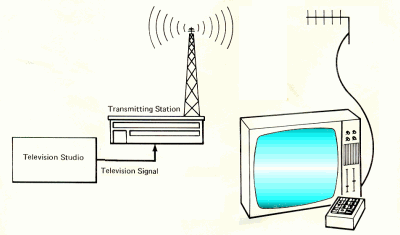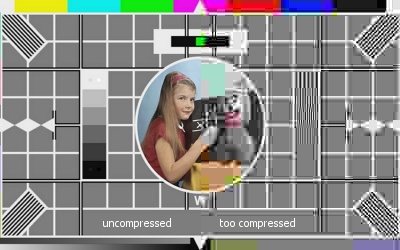Do I need to buy a booster?
 Brian Butterworth published on UK Free TV
Brian Butterworth published on UK Free TV With analogue television, it has often been necessary to buy an amplifier to improve the quality of the television picture, or to supply a steady on several televisions fed from the same aerial.
Many people have asked if it necessary to investing in a signal booster for Freeview.
"Analogue television" means is that the sound and pictures are broadcast using signals that are an "analogue" of the input. The sound and picture are transmitted from the source as electrical signals, then as radio waves and then back to sound and picture again.
In an analogue television camera, the image is scanned 25 times a second from side to side, from top to bottom and back. Where a lot of light is scanned, a high voltage is produced. Where no light is scanned, no voltage is produced. The output voltage is the same ratio to amount of light at scanned.
Leaving aside the technically, this signal is sent to the transmitter. The transmitter emits a radio wave on a known frequency, which is varied by the incoming voltage.

A microphone also converts the sound vibrations it picks up into a voltage, which when sent to the transmitter is added to another radio transmission frequency.
The signals are received by a television aerial pointing at the transmitter and converted back to very weak electrical signals. The sound is amplified and sent to a loudspeaker, and a picture created on the TV screen.
So on an analogue television, if the incoming signal is weak then the picture is dull as the background noise (the snow scene seen when an analogue television is not tuned) makes the picture less watchable.
The best analogue television set equipped with a great TV aerial located near to a high powered transmitter will produce brilliant pictures and clear sound. A poor set with an inadequate aerial or substandard cable will not.
If a weak signal is fed to a booster device, this will make the picture appear better on the television set or sets. It is often worth the investment.
Digital television
In a digital studio, the voltages from the cameras and microphones are not sent directly to the transmitter. It is converted into a stream of numbers inside a computer. The input voltage relates directly to the number in the computer. By sampling the input at a regular frequency, it is therefore possible to both store and transmit the information digitally this is what computers are good at.
It is therefore possible to take these numbers and generate a sound and picture output from them. However, the amount of information generated is over 240Mb/s, 30 times the rate of the fastest broadband connection.
Buy using computational techniques on this information the data can be compressed to as low as 2Mb/s, with as little as 6Mb/s being required for a good quality picture. These data compression techniques are called "lossy" because the reconstructed images are not identical to the originals, but look virtually similar to human eyes.

Digital television uses the same transmission frequencies as analogue uses, known as C21 to C68. The digital data is sent using a system called COFDM (Coded Orthogonal Frequency-Division-Multiplexing) which can carry data at a rate of 18Mb/s or 24Mb/s. Several television channels and some radio stations can be multiplexed together to produce exactly this amount of data.
At the receiver, it must be able to decode every single bit from these transmission multiplexes. A single error is impossible to correct for, so the decoder must have no errors.
Until switchover happens, the Freeview signals are being broadcast at very, very low power levels. However the COFDM system and sensitive digital equipment will, as long as the signal can be found and decoded there will be pixel-perfect reconstruction of the television channel. If the signal is drowned out by interference (especially from analogue transmissions) then no picture or sound will be output.
If the TV aerial installation you have provides you with all the Freeview channels, there is nothing to worry about.
If you are missing some channels because the signal is just too weak the best place to start is by improving the aerial, see Freeview reception - All about aerials. A bigger, higher, better designed aerial will always be the most sensible way to get perfect reception.
If you want to supply a signal to several sets, where the incoming signal is being "split" to serve several Freeview boxes, a masthead amplifier will be effective. This is because the signal is already of good quality and is being repeated for several sets.
However, if you are not getting a good signal from your aerial, a booster by the TV set will probably not help as this will simply boost the background interference as much as the Freeview signal.
In circumstances where an amplifier that has improved a picture on an analogue, it may be unsuitable for Freeview reception. Sometimes they will block one or more multiplex, where disconnecting the amplifier will restore the channels.
10:16 AM
christina smith:
A full post code would help us determine what the signal reception conditions are like at your location. The Digital UK Coverage Checker requires that fiull post code as it does not use village/town names as they are not specific enough.
If trees are blocking the signal from the ground-based transmitter then the obvious option is to use Freesat instead. That uses a satelite in geostationary orbit and can be received using a conventional dish and Freesat receiver (that equipment is very different from that used for Freeview).
Freesat carries most of the channels that are available via Freeview, there is no subscription needed either. Do not be misled into thinking it is anythiong to do with Sky Television and do not have a SkyQ LNB fitted to the dish.
| link to this comment |
7:22 AM
I have a Technika 15" LCD TV & DVD with a plug-in antenna (no outside aerial).
Reception, sound and picture quality are not good.
What would you recommend as the the best signal booster to use on this TV?
I am an OAP with little or no knowledge of this technology
Thank you for any help you could suggest.
| link to this comment |
9:18 AM
J Shaftoe: Most indoor aerials are rubbish (they are usually little more than a piece of wire sticking out of an amplifier) and adding further amplification will increase the amount of noise (unwanted signal) at the same time as boosting the wanted signals. If you provide a full postcode we can see which transmitters cover your location, where you are in relation to them and your predicted coverage, enabling further advice to be offered.
| link to this comment |
I'm 84. I lived in France for 30 years. I now live alone atop the cliffs at Folkestone, looking directly through my lounge window at Boulogne Mont Lambert Freeview (TNT) transmitter about 60 km (40 miles) away - over the horizon.
I cannot use a loft or roof aerial. I am able to receive Chans 32, 34 & 37 ((Mpx R7, R1, R6 ) reliably, and Chan 23 (Mpx R2) unreliably with a One For All amplified indoor loop aerial (SV9360 R01) plus a grill from my oven as a reflector. I get Chan 26 rarely & Chan 30 never.
I would like to try a compact yagi or log-periodic, and would really appreciate your advice or opinion on a type or a make & model that would cover the whole band reliably.
| link to this comment |
9:51 PM
James Carey:
So that we can determine the actual reception conditions for you, please would you provide a full post code for your location.
| link to this comment |
3:22 AM
James CAREY:
Oh I love the improvisation with the grill for the reflector. Sounds just like the sort of thing I did years ago when I was trying to dx Band I TV :) The trouble is it'll probably be too frequency dependant which is why you might be having problems with C26 & C30. Without doing some research there's also the possibility that those two muxes may also be lower power!
Whilst your postcode will help with any predicted UK Freeview reception, perhaps Mike has something that can predict reception of the Boulogne Mont Lambert (TNT) transmitter.
But I think it's just a case of a better set top aerial. The slight difficulty is that All for One don't actually specify the gain of that aerial. However a more directional wideband aerial with good gain may solve the problem.
Years ago the Telecam TCE2001 had good reviews but seems to be no longer available. The only similar one is the SLX Indoor TV Aerial 27769RG which also has good reviews and also got a best buy rating of 79% from Which. If you can afford it, it seems to be available from Currys/PC World for 24.99 or Amazon at 22.65. There may be other sources but I haven't checked. Hope that helps.
| link to this comment |